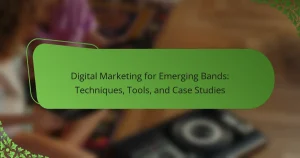Collaborative music projects enhance creativity, skill development, and networking opportunities for artists. This article explores the benefits of collaboration, highlights notable examples, and provides guidance on how to start your own project. Key platforms like Soundtrap and BandLab facilitate real-time collaboration, while understanding team dynamics and overcoming challenges can lead to successful outcomes. Metrics such as audience engagement and creative output quality help measure project effectiveness.

What are the key benefits of collaborative music projects?
Collaborative music projects offer numerous benefits, including enhanced creativity, skill development, and networking opportunities. They foster diverse perspectives, leading to innovative soundscapes. Participants can learn from each other, improving their musical abilities. Additionally, collaboration can increase exposure and reach, as artists share their audiences. Finally, these projects often result in lasting relationships and community building within the music industry.
How do collaborative projects enhance creativity?
Collaborative projects enhance creativity by combining diverse perspectives and skills. They foster innovation through shared ideas and collective problem-solving. Working together often leads to unexpected solutions and unique musical expressions. For example, artists from different genres can inspire each other, resulting in fresh sounds.
What role does networking play in collaborative music projects?
Networking is essential in collaborative music projects as it fosters connections, enhances creativity, and opens opportunities. By engaging with diverse artists, musicians can share ideas, skills, and resources, leading to innovative outcomes. Strong networks can also facilitate access to industry contacts, funding, and promotional channels, which are crucial for project success. Furthermore, collaboration often results in unique musical styles, as different influences merge, enriching the final product.
How can collaboration improve skill development?
Collaboration enhances skill development by fostering diverse perspectives and collective problem-solving. Engaging in collaborative music projects allows individuals to share knowledge, techniques, and creative ideas. This interaction accelerates learning and encourages experimentation, leading to improved musical abilities. Additionally, collaboration often results in unique compositions that reflect the strengths of each participant, enhancing creativity and innovation in the process.
What are the financial advantages of working collaboratively?
Collaborative music projects offer financial advantages such as shared costs, increased revenue potential, and access to diverse funding sources. By pooling resources, artists minimize individual expenses while maximizing opportunities for profit through joint performances and merchandise sales. Collaborations often attract larger audiences, resulting in higher ticket sales and streaming revenue. Additionally, partnerships can lead to grants or sponsorships that may not be available to solo artists.
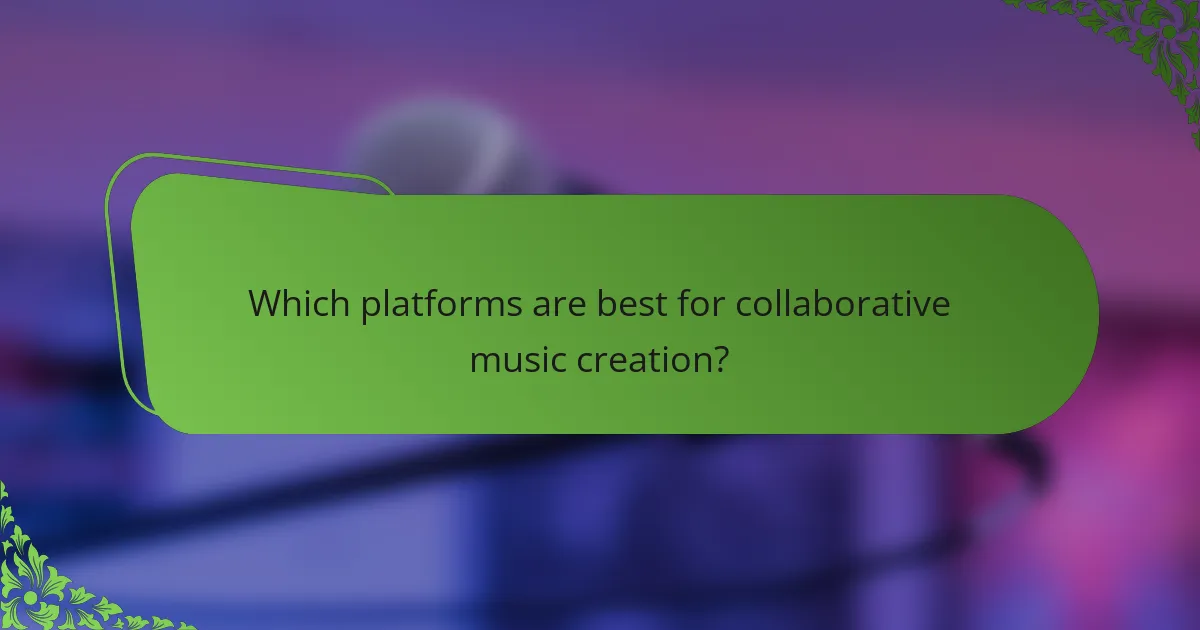
Which platforms are best for collaborative music creation?
Platforms best for collaborative music creation include Soundtrap, BandLab, Splice, and Audiomack. These tools facilitate real-time collaboration, offer cloud storage, and support multiple formats. For example, Soundtrap allows users to record, edit, and share projects seamlessly. BandLab provides social features for feedback and community engagement. Splice focuses on sample sharing and version control, while Audiomack enhances distribution capabilities. Each platform has unique attributes that cater to different collaborative needs.
What features should you look for in a music collaboration platform?
Look for user-friendly interfaces, real-time collaboration tools, file sharing capabilities, and integrated communication features in a music collaboration platform. These attributes enhance creativity, streamline workflows, and facilitate effective teamwork. Additionally, check for compatibility with various audio formats and mobile access to ensure versatility.
How do different platforms cater to various genres?
Different platforms cater to various music genres by providing tailored features and tools. For instance, platforms like SoundCloud focus on independent artists, enabling diverse genres to thrive. Spotify curates playlists for specific genres, enhancing discoverability. Bandcamp allows artists to showcase niche genres directly to fans. Each platform’s unique attributes attract specific audiences, fostering collaboration across genres.
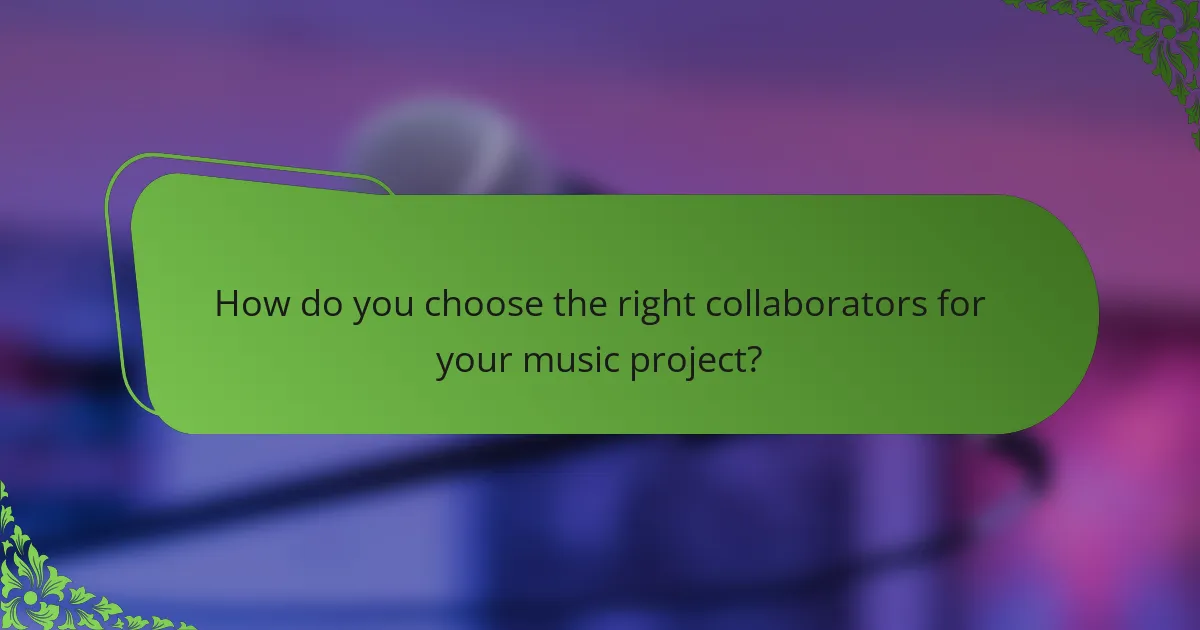
How do you choose the right collaborators for your music project?
Choose collaborators who share your vision, complement your skills, and bring unique perspectives. Start by identifying your project’s goals and the specific roles needed. Seek individuals with relevant experience and a collaborative mindset. Evaluate their past work and communication style to ensure compatibility. Prioritise diversity in skills and backgrounds to enhance creativity and innovation.
What qualities should you seek in a musical partner?
Seek a musical partner who shares your vision, complements your skills, and communicates openly. Look for qualities like creativity, adaptability, and a strong work ethic. A good partner should also be reliable, passionate about music, and willing to collaborate effectively. Shared interests in genres and styles can enhance synergy, leading to more productive projects.
How can you assess compatibility in musical styles?
To assess compatibility in musical styles, analyse shared elements like rhythm, melody, and genre influences. Collaborating artists should discuss their musical backgrounds and preferences to identify common ground. Listening to each other’s work can reveal how styles blend. Regular feedback during practice sessions fosters compatibility.
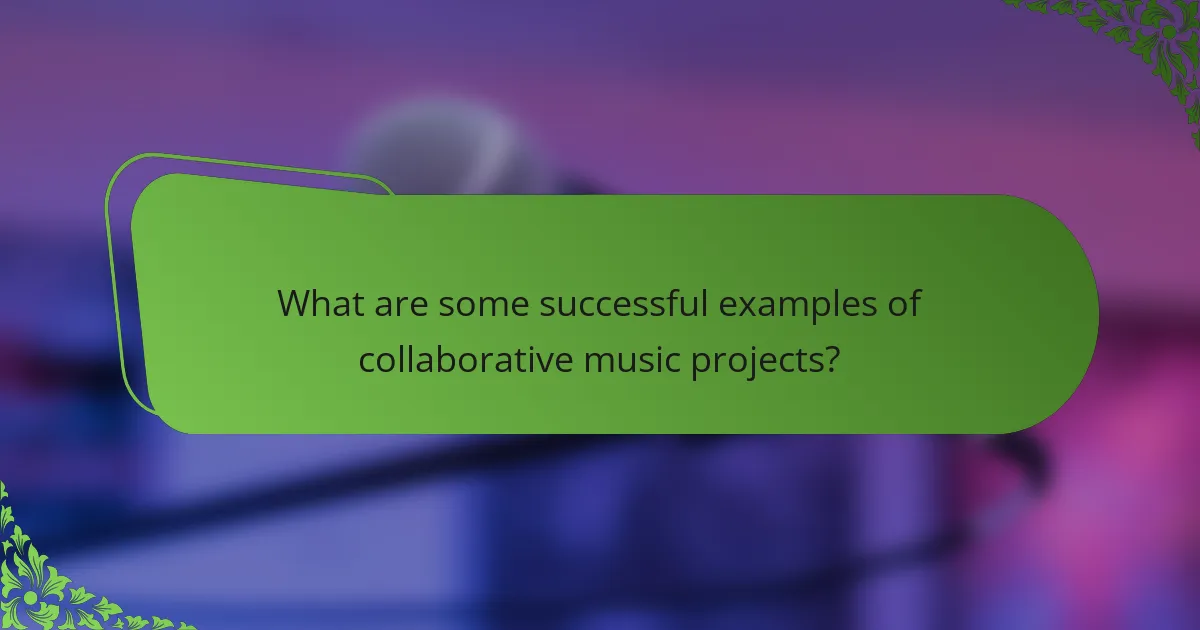
What are some successful examples of collaborative music projects?
Collaborative music projects often lead to innovative and successful outcomes. Notable examples include the supergroup Traveling Wilburys, which united iconic artists like Bob Dylan and Tom Petty, resulting in timeless hits. Another example is the charity single “We Are the World,” featuring numerous artists to raise funds for famine relief. The project Gorillaz blends virtual band members with various musicians, showcasing diverse styles. These collaborations highlight the unique ability of artists to create impactful music together, enriching the industry and fostering creativity.
Which notable artists have excelled in collaboration?
Notable artists excelling in collaboration include David Bowie, who partnered with Queen, and Kendrick Lamar, known for his work with SZA. Other examples are Beyoncé and Jay-Z, who created the album “Everything Is Love,” and the supergroup Traveling Wilburys, featuring Bob Dylan and Tom Petty. Collaborations often enhance creativity, broaden audiences, and fuse diverse musical styles.
How do genre-specific collaborations differ in approach?
Genre-specific collaborations differ in approach by focusing on distinct musical styles, techniques, and audience engagement strategies. Each genre brings unique characteristics that influence the collaboration process. For example, in pop music, collaborations often prioritise catchy hooks and mainstream appeal, while in jazz, improvisation and artistic expression are key. Furthermore, collaborations in electronic music may emphasise technology and production techniques, whereas folk music might focus on storytelling and acoustic instrumentation. These differences shape how artists interact, create, and promote their projects, ultimately impacting the final output and reception.
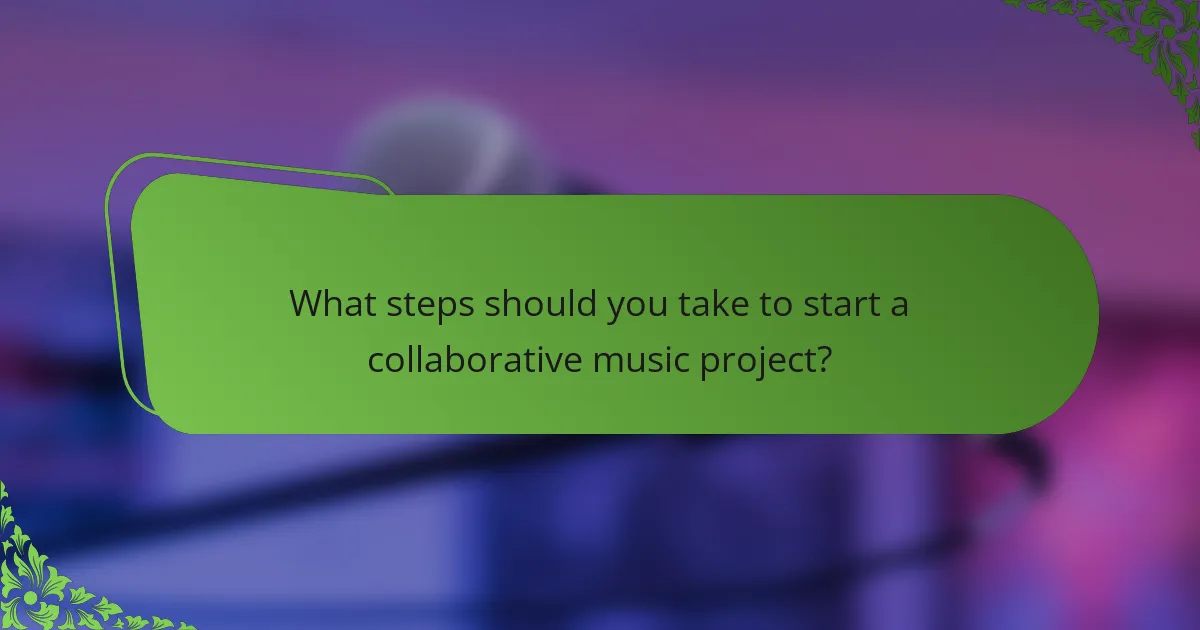
What steps should you take to start a collaborative music project?
To start a collaborative music project, identify your goals, gather a diverse team, establish clear communication, and create a shared vision. Begin by defining the musical style and objectives. Next, recruit musicians with complementary skills and backgrounds. Set up regular meetings to discuss progress and ideas. Finally, ensure everyone is aligned on the project’s vision and timeline.
How do you set clear goals and expectations with collaborators?
To set clear goals and expectations with collaborators, establish open communication from the start. Define specific objectives, roles, and deadlines collaboratively. Regular check-ins maintain alignment and address any issues. Use collaborative tools for transparency and documentation. This approach enhances accountability and project success.
What tools can facilitate the collaboration process?
Collaboration tools enhance the efficiency of collaborative music projects. Key tools include cloud storage for file sharing, communication platforms for real-time discussions, and digital audio workstations for collaborative editing. Examples are Google Drive for file management, Slack for messaging, and Ableton Live for music production. These tools streamline workflows and foster creativity among team members.
How can you manage creative differences effectively?
To manage creative differences effectively, establish open communication and mutual respect among collaborators. Encourage a culture where all ideas are valued and constructive feedback is prioritised.
Set clear goals for the project to align everyone’s vision. Use brainstorming sessions to explore diverse perspectives, fostering collaboration. Regular check-ins can help address issues early and maintain a cohesive direction.
Emphasise compromise and adaptability; this allows for innovative solutions that incorporate varied viewpoints. Celebrate achievements together to strengthen team bonds and motivation.
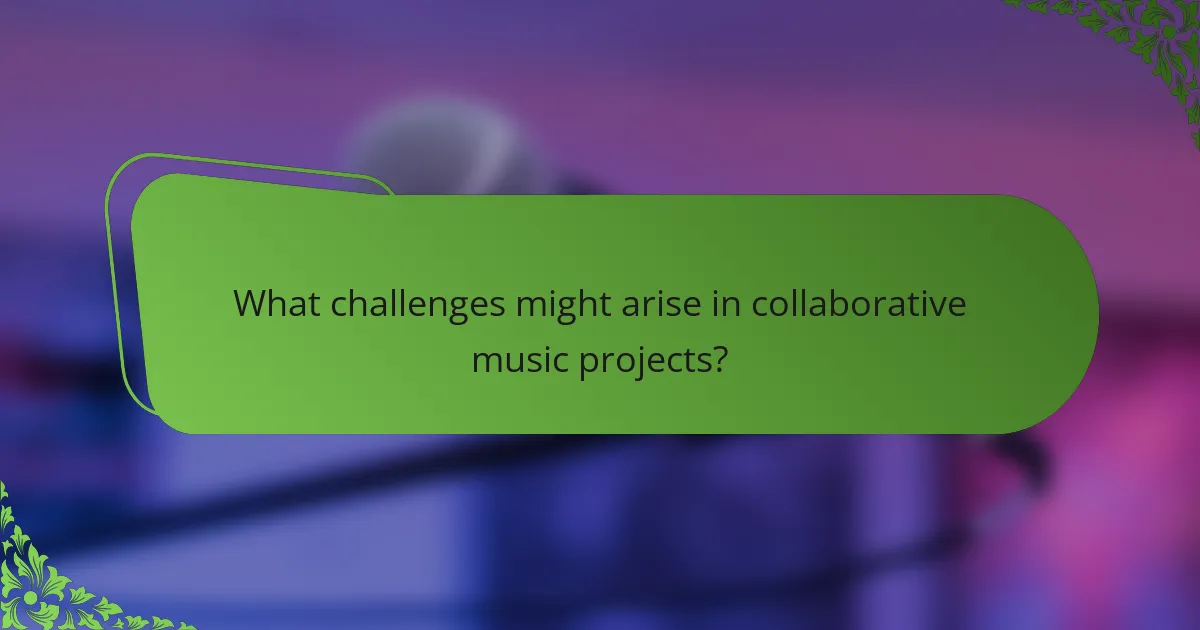
What challenges might arise in collaborative music projects?
Collaborative music projects can face several challenges. Communication issues often arise, leading to misunderstandings among team members. Conflicting creative visions can hinder progress, as differing opinions on direction may create tension. Time management is another significant challenge, as coordinating schedules can be difficult. Lastly, unequal contribution may occur, with some members feeling overburdened while others underperform. Addressing these challenges requires clear communication, defined roles, and mutual respect among collaborators.
How can communication issues impact collaboration?
Communication issues can significantly hinder collaboration in music projects. Misunderstandings may lead to conflicting ideas, reducing creative synergy. Clear communication fosters trust and alignment among collaborators, enhancing the project’s overall quality. Effective tools and strategies are essential to mitigate these issues and promote a harmonious working environment.
What are the common pitfalls to avoid in collaborative projects?
Common pitfalls in collaborative music projects include lack of clear communication, undefined roles, and inadequate planning. These issues can lead to misunderstandings and hinder creativity. Establishing open dialogue, assigning specific tasks, and setting timelines can enhance collaboration. Additionally, avoiding conflicts by addressing differences respectfully is crucial for project success.
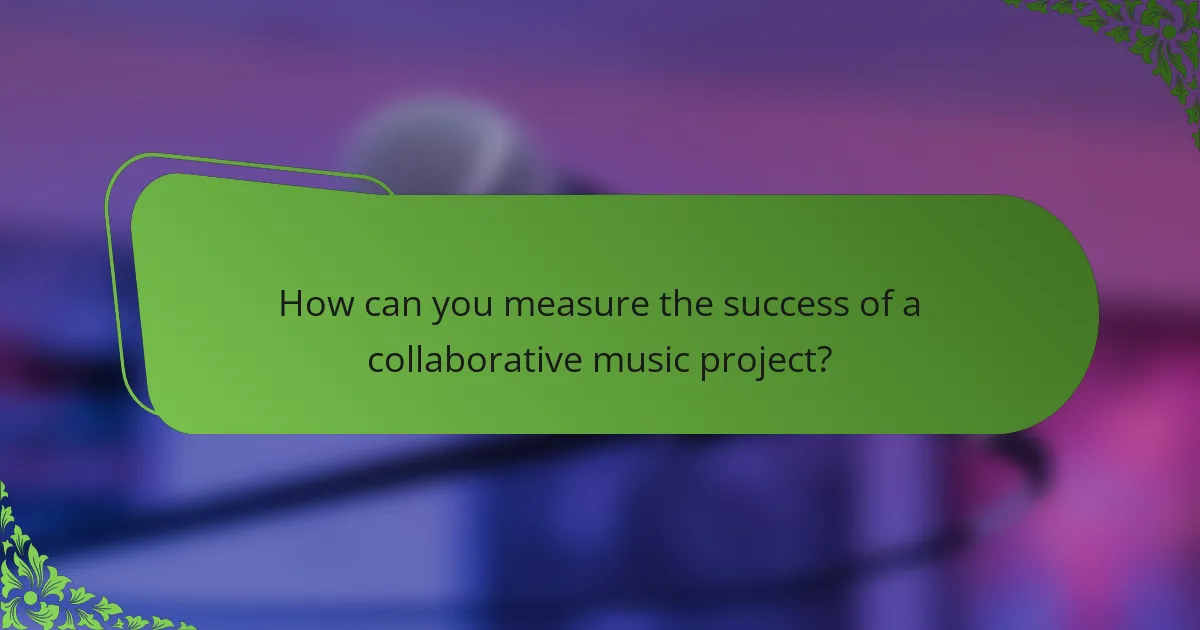
How can you measure the success of a collaborative music project?
Success in a collaborative music project can be measured through audience engagement, creative output quality, and team cohesion. Metrics include streaming numbers, social media interactions, and feedback from collaborators. Evaluating these factors helps determine the project’s overall impact and effectiveness.
What metrics can indicate a successful collaboration?
Successful collaboration in music projects can be indicated by metrics such as engagement levels, project completion rates, and audience feedback. Key metrics include the number of collaborative tracks produced, social media interactions, and streaming statistics. Additionally, qualitative feedback from participants can reveal satisfaction and creative synergy. Tracking these metrics helps assess the effectiveness of collaborative efforts.
How do audience reception and engagement factor into success?
Audience reception and engagement are crucial for the success of collaborative music projects. Positive reception boosts visibility and encourages participation, while high engagement fosters community building and collaboration. Successful projects often leverage social media and interactive platforms to enhance audience involvement. For example, projects that invite fan input can create a sense of ownership, driving further engagement. Ultimately, understanding audience dynamics can lead to more impactful collaborations and sustained interest.
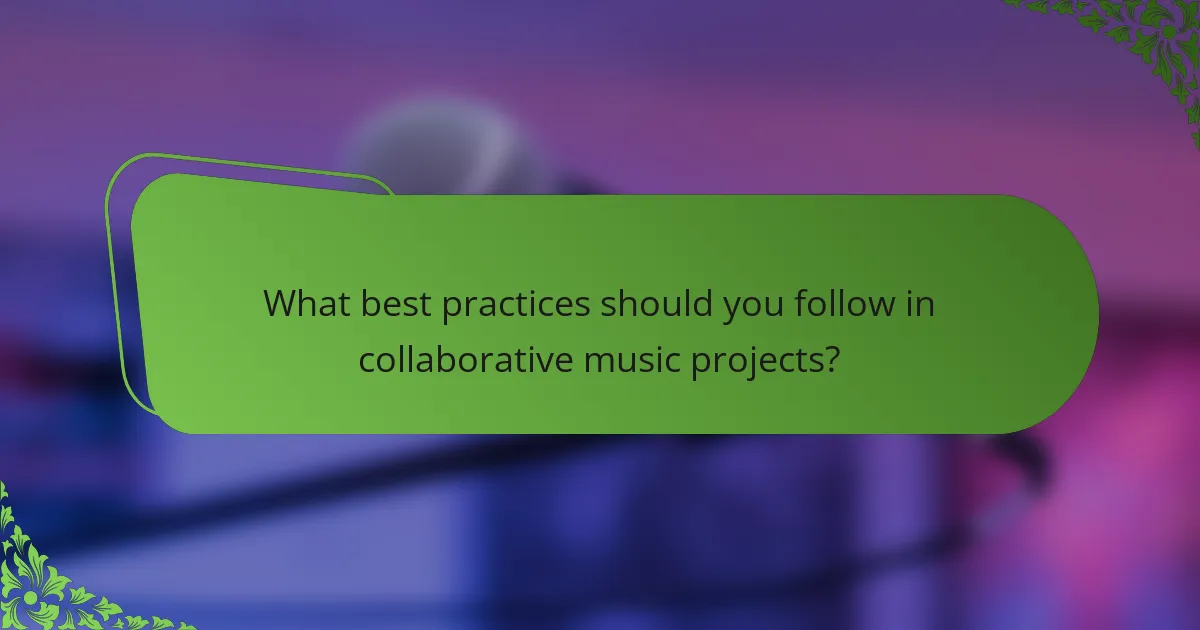
What best practices should you follow in collaborative music projects?
To succeed in collaborative music projects, prioritise clear communication, mutual respect, and defined roles. Establish a shared vision, set deadlines, and utilise collaborative tools for efficiency. Regular feedback sessions enhance creativity and keep the project aligned.
How can you foster a positive collaborative environment?
To foster a positive collaborative environment in music projects, prioritise open communication and mutual respect. Establish clear roles and responsibilities to enhance teamwork. Encourage creativity by allowing members to share ideas freely. Regular feedback sessions can strengthen relationships and improve outcomes. Celebrate achievements collectively to build camaraderie and motivation.
What strategies can enhance productivity in collaboration?
Collaborative music projects enhance productivity through clear communication, defined roles, and leveraging diverse skills. Establishing regular check-ins fosters accountability and progress tracking. Utilising collaborative tools streamlines workflow and encourages creativity. Setting shared goals aligns team efforts and maximises output.
What are common mistakes to avoid when collaborating in music?
To avoid common mistakes in music collaboration, focus on clear communication and defined roles. Misunderstandings can arise from vague expectations. Establishing a shared vision is crucial; without it, creative differences may lead to conflict. Additionally, neglecting to give and receive constructive feedback can stifle growth. Finally, failing to manage time effectively may result in missed deadlines and frustration.


